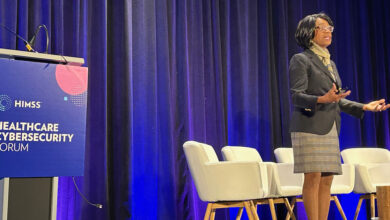Overhaul of Medicare Accountable Care Organization payments

Alex Kacik: Federal regulators have been trying to boost risk based contracting and healthcare. Their latest attempt is to give new Medicare Accountable Care Organizations advanced shared savings payments to jumpstart their operations. What’s been holding these programs back?
Welcome to Modern Healthcare’s Beyond the Byline, which offers behind the scenes look into our reporting. My name is Alex Kacik, senior operations reporter, and I’m joined by Maya Goldman, our rules and regulations reporter. Thanks for coming on Maya.
Maya Goldman: Thanks for having me, Alex.
Alex Kacik: All right Maya. CMS unveiled major changes to the Medicare Shared Savings Program the Primary Accountable Care Organization initiative, as part of its draft Physician Fee Schedule rule for next year. As a little background, ACOs are hospital and physician group partnerships that signed contracts with payers to share financial risk and accountable care organizations splits profits with CMS if profits are made and shares losses if losses occurred. So what did the changes to the program entail?
Read more: CMS releases Shared Savings Program results for 2021
Maya Goldman: So CMS proposed basically an overhaul of the Shared Savings Program, I think the agency actually uses that language itself. So it’s there are a lot of things going on here. But if finalized, ACOs would have more time to transition into performance based risk. So kind of that sharing losses part. And as you mentioned at the top of the episode, certain ACOs would be eligible for upfront payments to help them transition into the Shared Savings Program. There are a slew of other changes to like tweaks to the bent benchmarking methodology, which determines whether ACOs get money back from the federal government each year and risk adjustment. And providers and value-based care advocates are generally excited about the changes and think they’ll lead to positive improvements in the program. But there are some concerns which we can get into in a few minutes.
First, though, to zoom out a bit. Alex, ACOs are a big part of the healthcare industry’s move from paying for the volume of procedures to paying for the outcomes of those procedures. What has been the adoption rate of risk based contracting?
Alex Kacik: So yeah, there’s been a heavy reliance on what’s known as fee-for-service medicine and pays for the volume of care delivered. And there’s been a slow transition to change that payment paradigm because it’s just inherently a little bit more risky. And it’s a change of practices, especially for these legacy organizations. But there is a range of risk based contracts. Many large systems participate in shared savings contracts. There are bundled payments for procedures such as knee and hip replacements, and they’re growing and then specialties those are offers offered as well.
The riskiest bet is full capitation, which provides a lump sum to the providers before treatment. And if they provide care efficiently and effectively, they get to pocket the savings. But if something goes awry, and there’s some sort of complications, readmissions, they have to potentially pay out of their own pocket. So the adoption of so called downside risk has been slow. As a percentage of patient revenue for not-for-profit hospitals, capitation revenue was only 1.1% in 2016. That’s according to Moody’s medians they come out with every year. That’s only crept up to 1.7% by 2020.
As you noted to in your reporting Maya, that other shared savings program participation there has stagnated hovering around 11 million covered lives for at least the last three years. But CMS has a goal, to get 64 million plus Medicare beneficiaries into a value-based care arrangement by 2030. Tweaks to these programs, they hope, are going to make a big difference in adoption rate. But in the meantime, there isn’t enough incentive for health systems to move from fee-for-service. They say they those that have their own insurance arm, it’s a much easier lift, and you’ll see more adoption there. Otherwise, you know, these types of contracts take a lot of coordination between providers and payers, which isn’t the norm.
Not a Modern Healthcare subscriber? Sign up today.
Maya Goldman: I want to clarify that these there are risk based contracts across payers. So the Medicare Shared Savings Program is for Medicare in particular, but you sort of alluded to this private payers and Medicaid offer these kinds of arrangements as well. And that in itself makes coordination difficult for participating providers. And I think that that probably has something to do with with uptake as well.
Alex Kacik: Gotcha. So while providers support getting advanced payments to kickstart their ACOs they also asked for eliminating the distinction between high and low revenue accountable care organizations. Could you tell us more about that Maya?
Maya Goldman: Yeah, so in a 2018 rule, CMS divided ACOs into two categories. So you have the high revenue and the low revenue ACOs. In high revenue ACOs, which usually include hospitals, theoretically have more control over their Medicare spending and thus can take on more risk, at least according to CMS’ logic. And low revenue, ACOs are typically physician led and they’re given more time by CMS to transition into risk. And there’s also some data to suggest that low revenue ACOs performed better. Although I think that that’s sort of disputed.
Many provider and value-based care groups, including the National Association of ACOs have been upset by this distinction since it was proposed. But CMS in this most recent proposal uses the distinction to determine which ACOs are eligible for those upfront kickstarter payments that we talked about. This gets complicated because CMS has stated goal for the investment payments that kickstarter payments is to increase ACO uptake in underserved communities. And provider groups say, well, you know, ACOs with community health centers, rural health clinics, critical access hospitals, the ones who are actually touching those underserved patients, they’re often in high revenue ACOs. So and this isn’t going to touch those groups.
Another criticism of the designation is that if an ACO has, say, multiple physician practices, and one or two hospitals in encompassed in its organization, and those hospitals mean that it gets classified as high revenue, there’s no guardrail to stop the ACO from just removing those hospitals to gain the low revenue status. And then that makes it tricky because we’re not including all these groups that we might want to include in an ACO so providers say.
Read more: Providers urge CMS to change policy for split visit payment
But while we’re on underserved communities. Alex, what are the adoption rates of ACOs among rural counties?
Alex Kacik: So generally, there’s a big gap between rural and urban counties when it comes to risk based contracting. I found one study that looked at these trends across the Ohio primary care market from 2013 and 2015. So the caveat here is this, you know, one state, not a huge sample period. But some of the things we can draw from it are, you know, there was almost a 70% difference in ACO adoption rates between urban and rural communities. And the authors of the study published in 2021, said that, unlike programs that facilitated EHR adoption, there weren’t similar initiatives for ACOs. They also cited a shortage of specialists, a lack of data to coordinate care and the smaller size of these physician groups.
So when you’re small organization, it’s harder to rationalize the upfront capital investment, because it’s just going to eat up more of their operating budget. You know, we’ve talked about many times about this shortage of specialists and in rural communities too, and that can be a hindrance as well. And when it comes to the upfront capital investment, the mean cost per visit, increased by 13.5% amongst primary care clinics that joined a Medicare ACO compared to a 4.4% increase in clinics that did not join an ACO. So there’s a big gap in terms of that upfront expenditure.
Still there are some hopeful notes from the author’s during the time of the study and insurers introduced the Ohio Patient Centered Primary Care Collaborative to educate primary care practices about the potential benefits of ACOs. So they were hopeful that, you know, as more awareness and assistance comes into the foray, they could increase adoption over time.
Read more:
Senate advances short-term rural Medicare program extensions
New rural hospital model draws interest – and questions
Maya Goldman: Yeah, interesting. And that sort of seems to be what CMS is trying to do with with this latest proposed rule. I want to highlight one issue, especially that’s presented a roadblock for Medicare ACO adoption in rural areas. It’s a problem appropriately known as the “rural glitch.” Basically, ACOs can earn shared savings. That’s the money that they get back from the federal government by meeting a benchmark. And one of the elements that goes into creating this benchmark is a regional adjustment. So ACOs are measured based on how much money they save relative to the peers in their region, their local peers. And this is difficult for all ACOs because as they bring down costs for their patients, average regional costs come down to each year, making benchmarks harder and harder to achieve. This is especially hard for rural ACOs because they care for a larger portion of the local paper patient population than urban ACOs do at least according to the National Association of Accountable Care Organizations.
Alex Kacik: Maya, I’m just curious as you’re looking at this what, as especially in rural areas, what are payers and state and federal regulators urging, how are they trying to help more folks sign up for these types of programs? And what’s their strategy there?
Maya Goldman: Yeah. So in this proposal, CMS actually does make a specific mention of the ‘rural glitch. And industry players said in comment letters that they’re appreciative of the proposed policy change to sort of mitigate that these benchmark challenges are one of the really big roadblocks to participation in ACOs. And so CMS proposed a couple other changes that address these issues as well. The agency made it clear in the proposed rule that these proposed changes are also stepping stones to future bigger changes to ACO benchmarking.
You know, in the comment letters that I’ve read through from provider groups on the proposal. Generally they’re pretty excited about them. They request some pretty technical changes, but overall, they’re excited about the direction that CMS is headed. But there is one big ask from provider groups to allow ACOs already participating in the Shared Savings Program to opt into some of the changes that CMS proposed starting in 2024. So according to NACO’s, the National Association of ACOs, 43% of participating ACOs would not see benefits from this recent proposal until 2027. While new entrants would enjoy the improved benchmarking right away. And so provider groups are like, ‘Hey, wait, that’s not really fair.’ So I’m interested to see if CMS will make that change in the final rule.
Alex Kacik: And I know there’s a lot of attention placed on the solvency of the Medicare program. So I’m wondering how that plays into it. If the Medicare program runs out of funding, and I know there’s just like every year there’s these patchwork solutions to keep the program going. But I guess how does that factor into all this? If Medicare as the funding for that wanes.
Maya Goldman: Yeah, so I think at the root of this whole value-based care conversation is this fact that Medicare has been at the edge of financial crisis for years now. The latest projections say that the Medicare Hospital Trust Fund, which is Medicare Part A, will run out of money in 2028. And ACOs have been a key facet of the government’s movement away from that fee-for-service system over the past 10 years. But you know, there’s just been a real sort of plateau in participation and in the efforts of the federal government to sort of get these programs to take off. And I know providers are also concerned about a 5% bonus for participating in Advanced Alternative Payment Models that could expire soon if Congress doesn’t act.
So, you know, I think there’s a lot of reasons to be watching this value-based care space to see if this, you know, 10 year experiment is actually helping or if there’s something that the government needs to do to sort of kickstart this, what’s going on? Because there are some very passionate advocates in the government in provider circles, but there are also some people that are like, ‘I just don’t want to take that risk’, or ‘I can’t afford to take that risk.’ And if Medicare wants to stay solvent, which, you know, I think it’s the goal, there’s gonna have to be some kind of change.
Download Modern Healthcare’s app to stay informed when industry news breaks.
Alex Kacik: Maya, thanks for taking us down this rabbit hole of healthcare payments. I think it’s an interesting place to watch and appreciate your expertise, because it’s definitely complicated. So thanks so much for walking us through it.
Maya Goldman: Thanks, Alex. Always good to talk about these these wonky subjects with you.
Alex Kacik: All right. Thank you all for listening. You can subscribe to Beyond the Byline on Spotify, Apple podcasts or wherever you choose to listen. You can support the reporting of Maya, myself and our team of reporters by subscribing to Modern Healthcare, and giving us a follow us on Twitter and LinkedIn. Thank you for your support.




